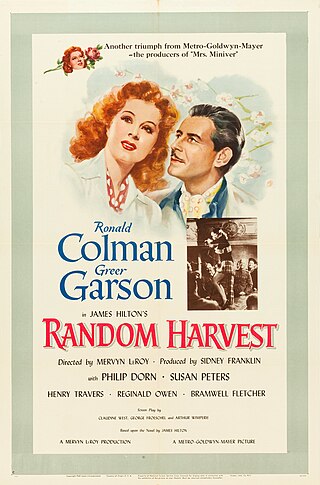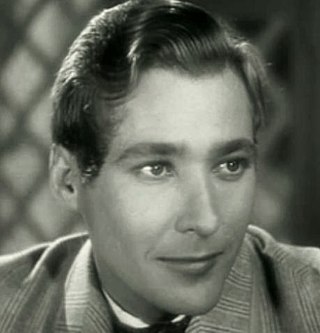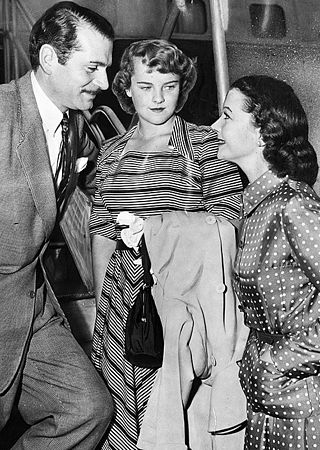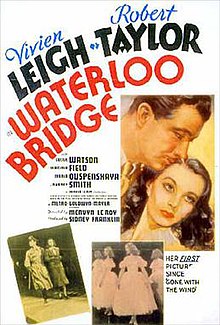
Vivien Leigh, styled as Lady Olivier after 1947, was a British actress. She won the Academy Award for Best Actress twice, for her performances as Scarlett O'Hara in Gone with the Wind (1939) and Blanche DuBois in the film version of A Streetcar Named Desire (1951), a role she had also played on stage in London's West End in 1949. She also won a Tony Award for her work in the Broadway musical version of Tovarich (1963). Although her career had periods of inactivity, in 1999 the American Film Institute ranked Leigh as the 16th-greatest female movie star of classic Hollywood cinema.

Random Harvest is a 1942 American romantic drama film based on the 1941 James Hilton novel of the same title, directed by Mervyn LeRoy. Claudine West, George Froeschel, and Arthur Wimperis adapted the novel for the screen, and received an Academy Award nomination. The novel keeps the true identity of Paula/Margaret a secret until the very end, something that would have been impossible in a film, where characters’ faces must be seen. This meant that the movie had to take a very different approach to the story. The film stars Ronald Colman as a shellshocked, amnesiac World War I veteran, and Greer Garson as his love interest.

Mervyn LeRoy was an American film director, producer and actor. In his youth he played juvenile roles in vaudeville and silent film comedies.

Katie Scarlett O'Hara Hamilton Kennedy Butler is a fictional character and the protagonist in Margaret Mitchell's 1936 novel Gone with the Wind and in the 1939 film of the same name, where she is portrayed by Vivien Leigh. She also is the main character in the 1970 musical Scarlett and the 1991 book Scarlett, a sequel to Gone with the Wind that was written by Alexandra Ripley and adapted for a television mini-series in 1994. During early drafts of the original novel, Mitchell referred to her heroine as "Pansy", and did not decide on the name "Scarlett" until just before the novel went to print. PBS has called O'Hara "quite possibly the most famous female character in American history..."

Robert Taylor was an American film and television actor and singer who was one of the most popular leading men of cinema.

Jill Esmond Moore was an English stage and screen actress.

Caesar and Cleopatra is a 1945 British Technicolor film directed by Gabriel Pascal and starring Vivien Leigh and Claude Rains. Some scenes were directed by Brian Desmond Hurst, who took no formal credit. The picture was adapted from the play Caesar and Cleopatra (1901) by George Bernard Shaw, produced by Independent Producers and Pascal Film Productions and distributed by Eagle-Lion Distributors.

Virginia Field was a British-born film actress.

Mae Clarke was an American actress. She is widely remembered for playing Henry Frankenstein's bride Elizabeth, who is chased by Boris Karloff in Frankenstein, and for being on the receiving end of James Cagney's halved grapefruit in The Public Enemy. Both films were released in 1931.

A Yank at Oxford is a 1938 comedy-drama film directed by Jack Conway and starring Robert Taylor, Lionel Barrymore, Maureen O'Sullivan, Vivien Leigh and Edmund Gwenn. The screenplay was written by John Monk Saunders and Leon Gordon. The film was produced by MGM-British at Denham Studios.

Waterloo Bridge is a 1931 American pre-Code drama romance war film directed by James Whale and starring Mae Clarke and Kent Douglass. The screenplay by Benn Levy and Tom Reed is based on the 1930 play Waterloo Bridge by Robert E. Sherwood.
Waterloo Bridge is a road and foot traffic bridge crossing the River Thames in London.

Gaby is a 1956 American drama film directed by Curtis Bernhardt and starring Leslie Caron, John Kerr, Cedric Hardwicke, Taina Elg and Margalo Gillmore. It is the third version of the 1930 play Waterloo Bridge, previously made into films Waterloo Bridge (1931) and Waterloo Bridge (1940). It is the only version of the play made in color, and the least faithful to it. The title, the names of the main characters, and plot details were all changed. Unlike the 1931 and 1940 versions, this film ends happily.

Anna Karenina is a 1948 British film based on the 1877 novel of the same title by the Russian author Leo Tolstoy.

Robert Douglass Montgomery was an American film actor.

The Deep Blue Sea is a 1955 British drama film directed by Anatole Litvak, starring Vivien Leigh and Kenneth More, and produced by London Films and released by Twentieth Century Fox. The picture was based on the 1952 play of the same name by Terence Rattigan.
Herbert Pope Stothart was an American songwriter, arranger, conductor, and composer. He was nominated for twelve Academy Awards and won Best Original Score for The Wizard of Oz. Stothart was widely acknowledged as a prominent member of the top tier of Hollywood composers during the 1930s and 1940s.

Ethel Griffies was an English actress of stage, screen, and television. She is remembered for portraying the ornithologist Mrs. Bundy in Alfred Hitchcock's classic The Birds (1963). She appeared in stage roles in her native England and in the United States, and had featured roles in around 100 motion pictures. Griffies was one of the oldest working actors in the English-speaking theatre at the time of her death at 97 years old. She acted alongside such stars as May Whitty, Ellen Terry, and Anna Neagle.
Waterloo Bridge: A play in two acts is a 1930 play by Robert E. Sherwood. It premiered on Broadway January 6, 1930 and ran until March 1930. It was the basis for three separate films: Waterloo Bridge (1931), Waterloo Bridge (1940), and Gaby (1956). It is based on the author's experiences during World War I.

Suzanne Farrington was the only child of British actress Vivien Leigh and her first husband, Herbert Leigh Holman. Upon her mother's death, Farrington was bequeathed her mother's papers, including her letters, photographs, contracts and diaries.


















